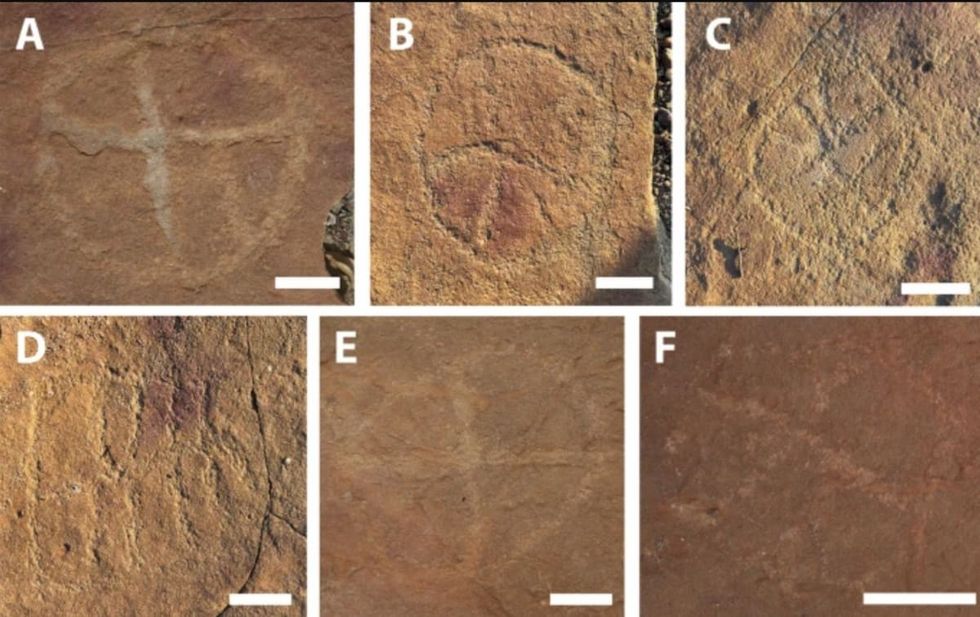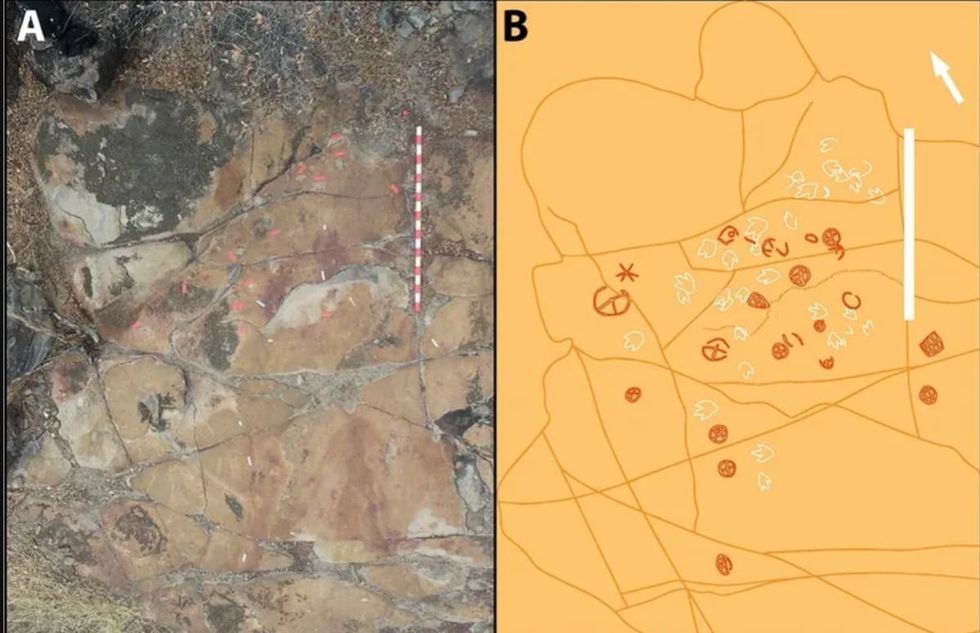Researchers in Brazil have uncovered a remarkable discovery that spans across millennia—dinosaur footprints found alongside ancient rock art dating back over 9,000 years. This significant find took place in Serrote do Letreiro, located in the Sousa Basin, and the research has been published in the journal Scientific Reports.
The study, led by Leonardo P. Troiano, Heloísa B. dos Santos, Tito Aureliano, and Aline M. Ghilardi, suggests that prehistoric hunter-gatherers in Brazil created mysterious rock art designs—known as petroglyphs—next to dinosaur footprints. These findings offer valuable insights into the intersection of paleontology and archaeology, particularly at the Serrote site.

The paper notes that while researchers first identified the petroglyphs in 1975, they only recently discovered these carvings close to massive dinosaur footprints. This discovery was facilitated by the innovative use of drones. The tracks, they said, belong to dinosaurs from the Cretaceous Period, which ended around 66 million years ago.
Researchers believe ancient humans deliberately placed these carvings next to the dinosaur prints, noting that some petroglyphs are only 2 to 4 inches away and may depict the footprints themselves.

This suggests that people of that era were deeply curious about the footprints and interacted with them. "The individuals who crafted the petroglyphs were acutely aware of the footprints, likely selecting the location precisely because of them," Leonardo Troiano, the study’s lead author and an archaeologist from Brazil's National Institute of Historic and Artistic Heritage, told Live Science "It would have been impossible to overlook their presence."
Troiano said these ancient humans were highly interested in the footprints and considered them meaningful in some way. This also goes parallel to the location of Serrote. Serrote do Letreiro, which translates to "Signpost Hill" in Portuguese, is close to the Valley of the Dinosaurs, a conservation area renowned for its hundreds of fossilized dinosaur footprints.

Troiano and his fellow researchers carried out the research with a group of middle-school students who surveyed the site in 2023. In addition to learning about the convergence of paleontology and archaeology, the students helped photograph the specimens. The team noted that the tracks belong to various types of dinosaurs, such as meat-eating theropods, long-necked sauropods, and two-legged ornithopods, including iguanodontian dinosaurs.
The petroglyphs uncovered were mainly carvings of circles filled with lines and other geometric strokes. These artworks are attributed to humans who lived in the region anywhere between 9,400 and 2,620 years ago. "They were small seminomadic groups of hunters and gatherers who lived in society and used objects made from stones," Troiano said. These ancient humans made these rock carvings with two techniques; perforation and scraping, the team said.
"Perforation involves using a kind of stone hammer to create depressions on the surface, resembling stippling, while scraping entails rubbing a stone against the surface until it forms the desired engraving," Troiano explained. The petroglyphs offer crucial evidence about the historical population and shed light on the rituals and practices of that time. “I think rock art creation was embedded in some sort of ritual context: people gathering and creating something, perhaps utilizing some psychotropics,” said Troiano, adding that these people were interested in “what the footprints represent.”
Affirming Troiano’s hypothesis, Jan Simek, a distinguished professor of anthropology at the University of Tennessee, told CNN, “The paper provides an interesting new example of how ancient people observed and incorporated fossils on the landscape into their religious experiences and interpretations.”
He said this case is another archaeological example of the “human tendency to tie the spiritual world created in the imagination to unexplained things in the world around us.”
This article originally appeared last year,


















 Pictured: The newspaper ad announcing Taco Bell's purchase of the Liberty Bell.Photo credit: @lateralus1665
Pictured: The newspaper ad announcing Taco Bell's purchase of the Liberty Bell.Photo credit: @lateralus1665 One of the later announcements of the fake "Washing of the Lions" events.Photo credit: Wikimedia Commons
One of the later announcements of the fake "Washing of the Lions" events.Photo credit: Wikimedia Commons This prank went a little too far...Photo credit: Canva
This prank went a little too far...Photo credit: Canva The smoky prank that was confused for an actual volcanic eruption.Photo credit: Harold Wahlman
The smoky prank that was confused for an actual volcanic eruption.Photo credit: Harold Wahlman
 Packhorse librarians ready to start delivering books.
Packhorse librarians ready to start delivering books. Pack Horse Library Project - Wikipedia
Pack Horse Library Project - Wikipedia Packhorse librarian reading to a man.
Packhorse librarian reading to a man.
 Fichier:Uxbridge Center, 1839.png — Wikipédia
Fichier:Uxbridge Center, 1839.png — Wikipédia File:Women's Political Union of New Jersey.jpg - Wikimedia Commons
File:Women's Political Union of New Jersey.jpg - Wikimedia Commons File:Liliuokalani, photograph by Prince, of Washington (cropped ...
File:Liliuokalani, photograph by Prince, of Washington (cropped ...
 Theresa Malkiel
commons.wikimedia.org
Theresa Malkiel
commons.wikimedia.org
 Six Shirtwaist Strike women in 1909
Six Shirtwaist Strike women in 1909
 U.S. First Lady Jackie Kennedy arriving in Palm Beach | Flickr
U.S. First Lady Jackie Kennedy arriving in Palm Beach | Flickr
